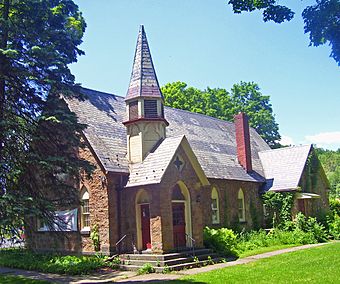Rosendale Library facts for kids
Quick facts for kids |
|
|
All Saints' Chapel
|
|

East profile and south elevation, 2008
|
|
| Location | Rosendale, New York |
|---|---|
| Nearest city | Kingston |
| Built | 1876 |
| Architectural style | Gothic Revival |
| NRHP reference No. | 86002511 |
| Added to NRHP | August 11, 1986 |
The Rosendale Library is a special building in Rosendale, New York, United States. It used to be called the All Saints' Chapel. This building was first built as a church in 1876. It has a unique style called Gothic Revival.
What makes it really special is that its outside walls are covered with Rosendale cement. This was a type of cement made right there in Rosendale. The building has faced some tough times. It was damaged by floods in the 1950s and a fire in the 1970s. After these events, a new group worked hard to save it. They turned the old church into a library. In 1986, the building was added to the National Register of Historic Places. This means it's an important historical site.
Contents
Exploring the Building's Design
The Rosendale Library is a one-story building. It has a main rectangular part and a smaller section called a chancel. Its walls are made from rough cement rock. These rocks are held together with Rosendale cement. You can see some fancy decorations around the windows and doors.
A fire in the mid-1970s caused a lot of damage inside. Most of the original inside decorations had to be replaced. However, the beautiful wooden ceiling is still there. Also, almost all of the stained-glass windows were replaced. The church was designed to hold about 150 people.
Outside Features of the Chapel
The most noticeable part of the outside is the steep roof. It has a pointed top called a gable. This gable is decorated with a special wooden design. It includes shapes like a quatrefoil (four leaves) and trefoils (three leaves). The roof is made of slate tiles. These tiles are laid in pretty patterns of scallops and flowers.
There is a small entrance area on one side. On the other side, there's a small room called a vestry. On the west side, you can see a six-sided tower. This tower has simple Gothic designs at its base. It also has openings at the top for sound to come out. A new section was added to the building in the 1970s. It was designed to match the old part.
A Look at the Chapel's History
The town of Rosendale grew quickly in the late 1820s. This happened because the Delaware and Hudson Canal opened nearby. In 1874, a church from Stone Ridge started a mission in Rosendale. It was called St. John's Mission. Within two years, it had enough people to need its own church building.
Building the Chapel and Its Early Years
People raised $2,000 to build the church. It was finished in 1877. The mission then changed its name to All Saints'. By 1893, All Saints' became a full church parish. It even started its own missions in smaller towns nearby. These included Bloomingdale and Rifton.
Challenges and Transformation into a Library
In 1956, a big flood damaged the church. This was after Hurricane Flossy. The damage was so bad that the church had to close. The parish was then officially ended.
In 1957, Andrew Snyder bought the building. His family had made a lot of money from Rosendale cement. He told a local women's club he would give the building to them. But only if they organized it to be a library. The club members formed the Rosendale Library Association. After they fixed it up, the old chapel opened as a library in 1959.
Repairs and Official Library Status
A fire in 1975 caused more damage to the building. The inside decorations and most of the stained-glass windows had to be replaced. During these repairs, a new section was added to the west side. This section had been planned a long time ago.
In the 1980s, the building was listed on the National Register of Historic Places. The New York State Legislature then passed a law. This law allowed a special library district to be created. Voters in Rosendale approved this in 1987. The library district officially started two years later. Work on the library building continues even today. In the 2000s, the library received a grant to fix its slate roof. They are currently raising money to match this grant.
The Chapel's Unique Style
The church's basic look, with its thick walls and tall, narrow windows, is like old English country churches. These churches were some of the first to use the Gothic Revival style. The arched windows and brick frames also match the local building styles. These styles were common for churches built by English families in the Hudson Valley. You can even see shells embedded in the outside walls. These details, and others, show influences from a style called Venetian Gothic.
Why Rosendale Cement?
The most unusual part of the building's design is its outside finish. Usually, the rough stone walls in such buildings are left bare. But here, they were covered with Rosendale cement. This was likely done to show off a local building material. This cement had made many people in the area rich and successful.
See also
- Mid-Hudson Library System

